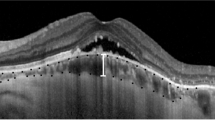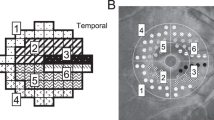Abstract
Purpose
To compare the macular functions of patients with excellent visual acuity after retinal detachment (RD) surgery, with the healthy fellow eye.
Methods
Of 214 patients, nine patients, who were successfully operated because of unilateral RD involving the macula and achieved excellent visual acuity, were analysed. The fellow eyes of the patients were taken as the control group. The macular functions were evaluated with visual acuity, contrast sensitivity, colour vision, visual field, and pattern VEP in operated and nonoperated eyes.
Results
There was no significant difference in visual acuity, contrast sensitivity, colour vision, and VEP outcomes between operated and nonoperated eyes. However, it was seen that the mean deviation in the visual field was significantly higher in the operated eyes (5.8±1.8 dB) when compared with the undetached fellow eyes (3.1±1.8 dB), (t=12.5; P=0.013).
Conclusion
Even though the visual acuity, colour vision, contrast sensitivity, and VEP results returned to normal after a successful RD surgery, we found that the mean deviation measured by the visual field, which reflects the retinal sensitivity, was still significantly low after nearly 5 years follow-up.
Similar content being viewed by others
Introduction
The anatomical success rate was declared between 88 and 97% after the retinal detachment (RD) surgery.1 On the other hand, functional recovery is far from expected.2, 3
We decided to compare the macular functions of nine cases with excellent Snellen acuity after retinal reattachment, with the healthy fellow eye, through psychophysical (contrast sensitivity, colour vision, visual field), subjective (visual acuity), and objective (visual evoked potentials) tests.
Materials and methods
Of 214 cases, operated owing to macula — off RD in the ophthalmology department of Trakya University were scanned. The unilateral RD cases with an anatomical and functional success after the surgery were selected. A total of 18 eyes of nine patients who were followed up for at least 12 months and the best corrected visual acuity was better than 0.8 in Snellen chart, in both eyes, were enrolled. While the nine eyes that had conventional RD surgery (2.5 mm circling band and drainage of the subretinal fluid) formed the operated group (Group 1), the fellow eyes formed the nonoperated group (Group 2). The macular functions of 18 eyes of these nine invited patients were tested through psychophysical (contrast sensitivity, colour vision, visual field) and objective (VEP) tests and were compared in groups.
Contrast sensitivity testing were carried out with the Cambridge low spatial frequency wall cards4 and colour vision was carried out by the Lanthony 40-Hue test in a standard way. Visual field tests were taken with the macular program (M1) of Octopus 500 EZ automatic perimeter. The distribution of eyes with the mean deviation smaller and equal to 2 dB and greater than 2 dB were compared in operated and nonoperated group. For objective evaluation, pattern VEP was carried out.
Mann Whitney U test and Fisher's exact tests were used in the statistical evaluation.
Results
Three of nine patients were female, and six of them were male. The mean age was 52.1±12.7 years (25–65 years) and the mean observation period was 59±41.4 months (13–130 months). All patients, except one pseudophakic in either group, were phakic.
While the visual acuity of the operated cases varied from 0.8 to 1.0, the visual acuities of all fellow eyes were 1.0 in the Snellen chart. Visual acuities were converted to log MAR values. There were no significant differences between the visual acuities, contrast sensitivity scores, colour vision defect scores, P-100 latencies, and P-100 amplitudes of two groups (Table 1).
The mean deviation in the visual field was >2 dB in all nine eyes in the operated group and it varied from 3.1 to 8.8 (average 5.8±1.8 dB). In the control group, mean deviation varied from 0.6 to 5.4 dB (average 3.1±1.8 dB). The difference in mean deviation between two groups was found statistically significant. The average of the mean deviations was higher in the operated group (t=12.5; P=0.013). The distributions of the eyes in the operated and nonoperated groups with mean defect ≤2 and >2 dB were determined in Table 2. The ratio of the eyes with mean defect >2 dB is higher in the operated eyes than that in the control group significantly (P=0.03).
Discussion
Anderson et al,5 compared the contrast sensitivity of the cases after RD surgery with that of the control group and remarked that the contrast sensitivity of the patients reduced, but they were failed to allow for the effects of visual acuity. In our study, however, we also found that contrast sensitivity was reduced in the operated group, but the difference between the operated and nonoperated groups was not statistically significant regarding the contrast sensitivity.
Kreissig et al,6 reported that, 26 of their 48 patients had defective colour vision 3 months after macular reattachment. Eleven of 26 colour-vision-disturbed patients recovered 1 year after surgery. Also, it was mentioned that any patient with visual acuity above 0.6 has no colour vision deficiency. We also found that there was not a statistically significant difference between operated and nonoperated eyes in terms of colour vision after nearly 5 years follow-up.
Chisholm et al,7 used Goldmann's kinetic perimeter and mentioned that the retinal sensitivity did not recover after retinal reattachment. Amemiya et al,8 pointed out that although an objective visual field recovery was observed after the surgery, the 34% of the patients did not recover subjectively considering the visual fields and in fact they became worse. In this study, we were in agreement with the previous reports that the mean deviation in visual field in the operated eyes was higher than that of the fellow eyes. In other words, even though the visual acuity recovered to normal levels after surgery, there was a prominent retinal sensitivity defect in central visual field. Also, the ratio of the eyes with the mean deviation >2 dB were significantly higher in the operated group, than that of the fellow eyes.
Ueda et al,9 suggested that even after successful RD surgery, P-100 latencies were significantly longer than that of the fellow eyes of the patients, however, they did not consider the visual acuities of the patients. In our study, we found that there was not a statistically significant difference, between the retinal reattached eye and the undetached fellow eyes, regarding the average of P-100 latencies and amplitudes in VEP.
Statistical analysis with such few cases may not be so valid, but our inclusion parameters were so tight. To get free the effect of visual acuity on measured outcomes, only cases with visual acuity in both eyes that were better than 0.8 were selected from such a big RD surgery case group.
In conclusion, we observed that if visual acuity can be returned to normal, a sufficient vision quality (recovery of the contrast sensitivity, colour vision, P-100 latency and the P-100 amplitudes) can be obtained, even in a long time. However, the mean deviation in visual field, which reflects the retinal sensitivity, is prominent nearly 5 years after macular reattachment, even if the visual acuity is normal.
References
Michels RG, Wilkinson CP, Rice TA . Retinal Detachment. The CV Mosby Co.: Missouri, 1990 pp 1–27, 459–505, 917–958.
Wilkinson CP . Rhegmatogenous retinal detachment. In: Yanoff M, Duker JS (eds). Ophthalmology. Mosby International Ltd: London, 1999, pp 1–7.
Tani P, Robertson DM, Langworthy A . Prognosis for central vision and anatomic reattachment in rhegmatogenous retinal detachment with macula detached. Am J Ophthalmol 1981; 92: 611–620.
Leat SJ, Woo GC . The validity of current clinical tests of contrast sensitivity and their ability to predict reading speed in low vision. Eye 1997; 11: 893–899.
Anderson C, Sjöstrand J . Contrast sensitivity and central vision in reattached macula. Acta Ophthalmol 1981; 59: 161–169.
Kreissig I, Lincoff B, Witassek B, Kolling G . Color vision and other parameters of macular function after retinal reattachment. Dev Ophthalmol 1981; 2: 77–85.
Chisholm IA, McClure E, Foulds WS . Functional recovery of the retina after retinal detachment. Trans Ophthalmol Soc UK 1975; 95: 167–172.
Amemiya T, Iida Y, Yoshida H . Subjective and objective ocular disturbances in reattached retina after surgery for retinal detachment, with special reference to visual acuity and metamophopsia. Ophthalmologica 1983; 186: 25–30.
Ueda M, Adachi-Usami E . Assessment of central visual function after successful retinal detachment surgery by pattern visual evoked cortical potentials. Br J Ophthalmol 1992; 76: 482–485.
Author information
Authors and Affiliations
Corresponding author
Additional information
This study was not presented or published anywhere
We have no proprietary interest
Rights and permissions
About this article
Cite this article
Özgür, S., Esgin, H. Functional assessment of reattached macula in nine cases with excellent Snellen acuities. Eye 21, 503–505 (2007). https://doi.org/10.1038/sj.eye.6702241
Received:
Accepted:
Published:
Issue Date:
DOI: https://doi.org/10.1038/sj.eye.6702241



